Landscaping your home or construction project in Secret Beach requires a thoughtful blend of aesthetic appeal, environmental sustainability, and practicality, all while respecting the local Belizean influence and the tropical coastal environment. Here’s an approach that aligns with these principles:
- Native Plant Selection: Utilize native plants, which are adapted to the local climate and require less water and maintenance. These might include flowering plants like Hibiscus, Bougainvillea, and Frangipani, which add vibrant colors, and palms like Coconut or Royal Palms for structure and shade.
- Water Conservation: Implement xeriscaping principles where possible. This technique involves selecting drought-tolerant plants and arranging them in, efficient, water-saving ways. Consider using a drip irrigation system, which is more efficient than traditional sprinklers.
- Outdoor Living Spaces: Create outdoor living areas that seamlessly integrate with the natural environment. This can include shaded seating areas, outdoor kitchens, or even a fire pit, using materials like local hardwoods or stone that blend with the natural surroundings.
- Pathways and Walkways: Use natural materials like crushed shells, pebbles, or local stone for pathways. These materials complement the tropical setting and are permeable, allowing for better rainwater absorption.
- Sustainable Practices: Incorporate sustainable practices such as rainwater harvesting for irrigation and solar-powered lighting for pathways and outdoor areas.
- Wildlife Friendly: Design with local wildlife in mind. This could involve planting nectar-rich flowers to attract butterflies and hummingbirds, or including small water features for birds and insects.
- Privacy and Windbreaks: Strategically place plants and trees to create natural privacy screens and windbreaks, enhancing comfort and reducing wind erosion.
- Beachfront Considerations: If the condo is beachfront, ensure landscaping respects the delicate beach ecosystem. Avoid planting too close to the shoreline to prevent erosion and use plants that are salt-tolerant.
- Cultural Elements: Incorporate Belizean cultural elements subtly in the landscape design, such as traditional sculptures or locally crafted decorative elements.
- Maintenance Plan: Finally, create a sustainable maintenance plan that uses organic fertilizers and pest control methods to keep the landscape healthy and thriving.
Each element is chosen to ensure the landscape is not only visually stunning but also practical and sustainable, reflecting the beauty and character of the Caribbean environment. Let’s dive deeper into each concept listed above. By combining the best ideas and best practices for the Secret Beach area of Belize; not only can we create landscaping that’s beautiful to look at but also contributes naturally to the native environment of San Pedro and Ambergris Caye.

Expanding on the use of native plants in landscaping around your home at Secret Beach, especially with a focus on Belizean influences:
- Native Plant Selection:
- Flowering Plants:
- Hibiscus: Known for their large, vibrant flowers, these are perfect for adding a splash of color to gardens and borders. They thrive in the Caribbean climate and can be used to create stunning hedge lines or focal points in the garden.
- Bougainvillea: These are excellent for adding a lush, vibrant look. They can be trained to climb trellises or walls, providing a beautiful vertical element. Their drought tolerance makes them ideal for the Caribbean climate.
- Frangipani (Plumeria): Famous for their fragrant flowers and used in traditional Caribbean leis, these can be planted as standalone specimens or in groups. Their sweet scent adds an aromatic dimension to the landscape.
- Palms:
- Coconut Palm: An iconic symbol of the tropics, these palms provide both aesthetic appeal and practical benefits. They offer shade, and their coconuts can be used in the condo’s culinary offerings.
- Royal Palm: Tall and elegant, Royal Palms create a striking visual statement. They are ideal for lining pathways or as a majestic focal point in open spaces.
- Ground Covers and Shrubs:
- Sea Grape (Coccoloba uvifera): With broad, round leaves and edible fruits, Sea Grape is ideal for beachfront properties. It’s salt-tolerant and helps in stabilizing sandy soils.
- Beach Morning Glory (Ipomoea pes-caprae): This ground cover is perfect for beach areas, with its sprawling habit and tolerance to sandy soils and salt spray.
- Shade Tolerant Plants:
- For areas under the canopy or in the shadows of buildings, shade-tolerant plants like Ferns and Philodendrons can be used. They add a lush, green understorey and are low maintenance.
- Flowering Plants:
These plants not only enhance the visual appeal of the landscape with their colors, textures, and forms but also play crucial roles in the local ecosystem. They provide habitats for local wildlife, help in soil conservation, and maintain the natural balance. Moreover, being native, they require less water and are more resilient to local pests and diseases, aligning with sustainability goals.
Regarding the concept of water conservation. When planning the landscaping of a luxury home in the Caribbean you’ll want to consider some of the following factors:
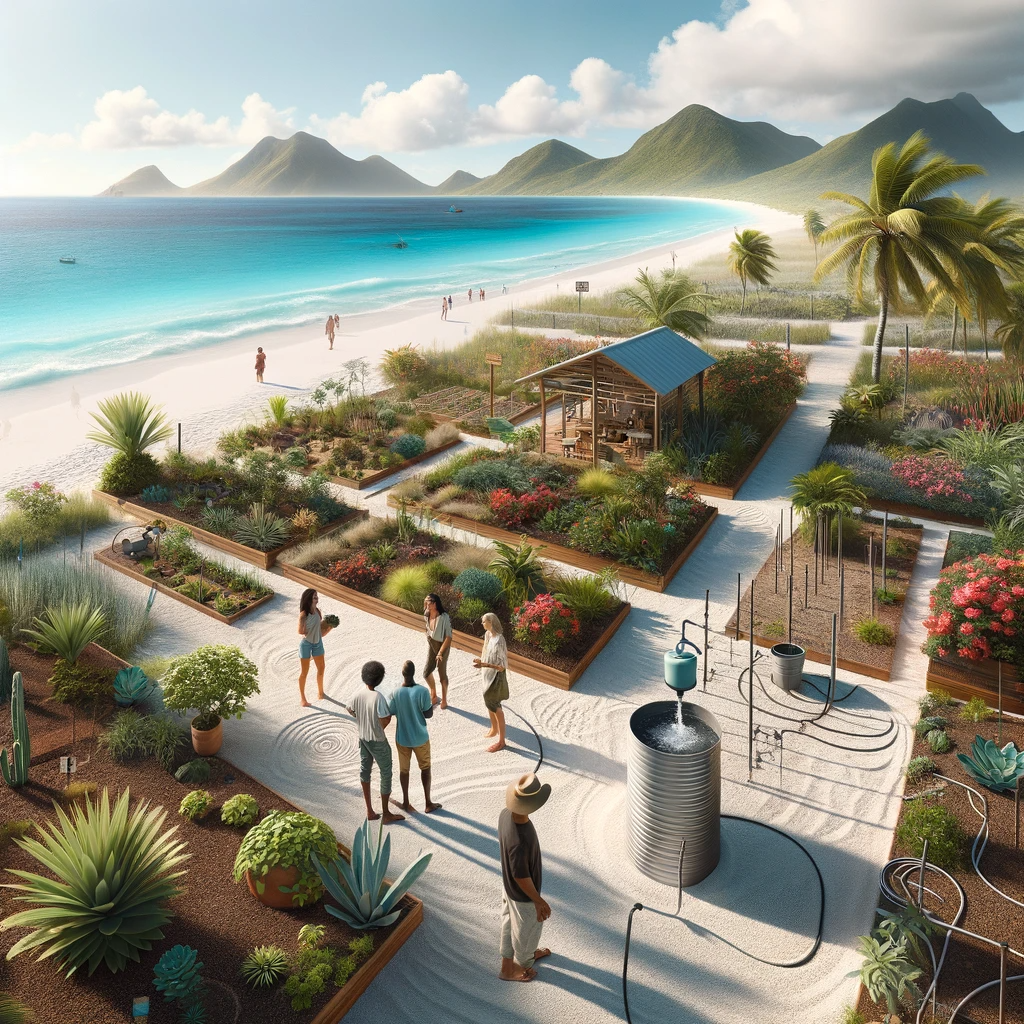
- Water Conservation:
- Xeriscaping Principles:
- Plant Zoning: Grouping plants with similar water needs together. This ensures efficient use of water, as plants requiring more moisture can be irrigated accordingly, without overwatering others.
- Mulching: Using organic mulch around plants to reduce evaporation, regulate soil temperature, and minimize water runoff. Mulch also adds an aesthetic element and helps in weed control.
- Drought-Tolerant Plants: Selecting plants that naturally thrive in dry conditions. These plants, once established, require minimal water and are ideal for sustainable landscapes.
- Efficient Irrigation Systems:
- Drip Irrigation: Installing drip irrigation systems delivers water directly to the roots of plants, minimizing evaporation and runoff. It’s particularly effective in targeted watering of specific areas or plants.
- Timed and Automated Systems: Using timers and automation in irrigation systems ensures that watering happens at the most effective times, usually early morning or late evening, to reduce evaporation.
- Rainwater Harvesting:
- Rain Barrels and Cisterns: Rain barrels are the main source of water for homes in Secret Beach as well as many other areas of Ambergris Caye. Installing systems to collect and store rainwater from rooftops and paved areas. This harvested water can be used for irrigation, further reducing the dependence on municipal water sources.
- Swales and Rain Gardens: Designing the landscape to include swales or rain gardens can help in capturing runoff, allowing it to percolate into the ground. These features can be aesthetically designed with rocks and native plants.
- Soil Management:
- Adding Organic Matter: Incorporating organic matter like compost into the soil improves its water retention capabilities, reducing the need for frequent watering.
- Proper Aeration and pH Balance: Ensuring the soil is well-aerated and maintaining the right pH balance are crucial for water absorption and the health of the plants.
- Water-Efficient Lawn Alternatives:
- Artificial Turf: Where a green lawn look is desired, consider using high-quality artificial turf that requires no watering, mowing, or fertilizers.
- Ground Covers: Using low-growing ground covers instead of traditional grass can significantly reduce water usage. These could include native grasses or creeping plants.
- Education and Awareness:
- Resident Awareness: Educating Secret Beach residents about the importance of water conservation and how the landscaping choices reflect this commitment. This could include information about the native plants used and the benefits of the implemented water-saving techniques.
- Xeriscaping Principles:
By incorporating these water conservation strategies, the landscaping not only becomes more sustainable but also more cost-effective in the long run, reducing the overall environmental footprint of homes at Secret Beach, Belize.
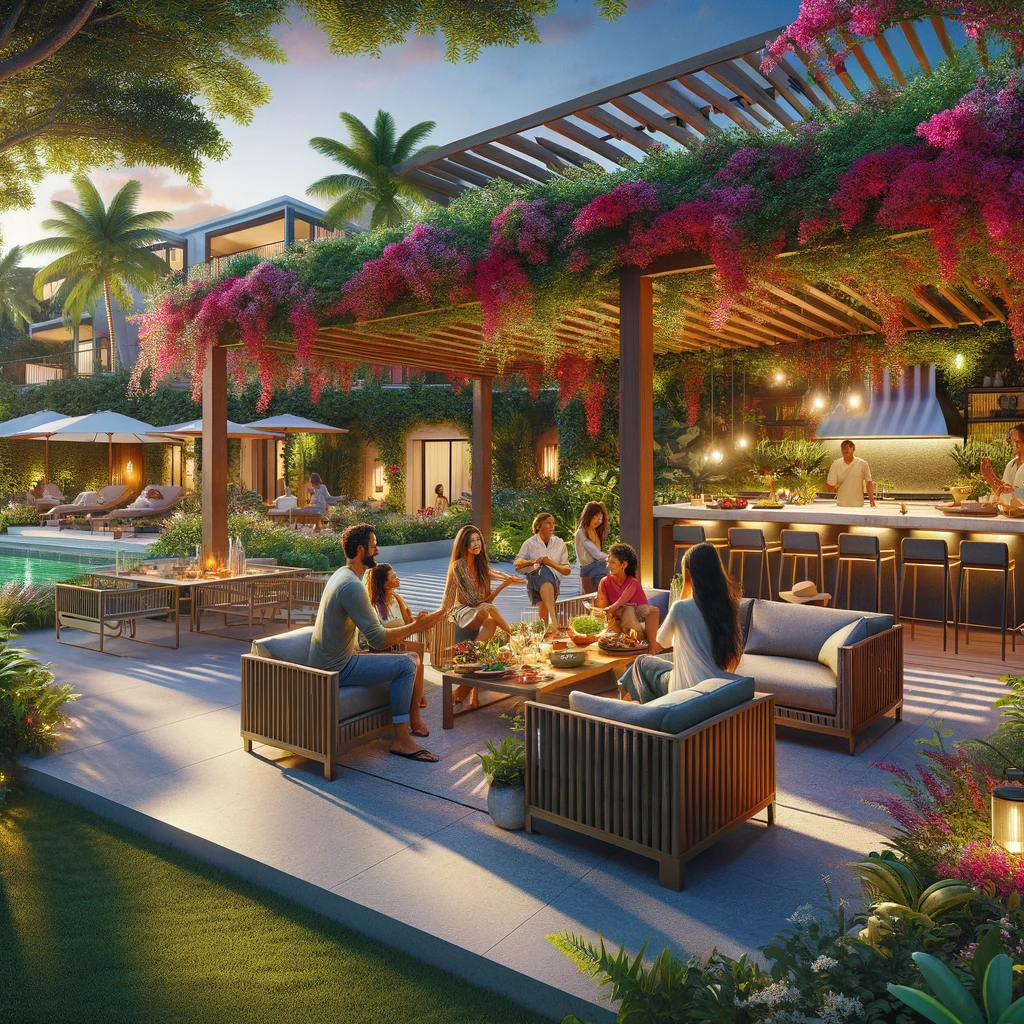
Don’t forget about your outdoor living spaces! Bringing the inside, outside. Great outdoor living space blends the elements of the manmade and natural worlds, as a place to gather, eat, share, and enjoy. Consider these things when creating your outdoor living space.
- Outdoor Living Spaces:
- Shaded Seating Areas:
- Pergolas and Gazebos: Constructing pergolas and gazebos with materials like local hardwoods. These structures provide shaded areas where residents can relax, dine, or socialize. They can be adorned with climbing plants like Bougainvillea for added beauty.
- Canopies and Awnings: Installing retractable canopies or awnings made from durable, weather-resistant materials. These can be used to provide shade over patios or decks.
- Outdoor Kitchens and Dining:
- Built-in Grills and Barbecue Pits: Incorporating outdoor cooking facilities, like grills and barbecue pits, for an enjoyable outdoor dining experience. These can be designed with stone or brick to blend with the natural surroundings.
- Dining Furniture: Placing weather-resistant dining furniture, ensuring it complements the overall design theme of the condo. Teak or wicker furniture with comfortable cushions can offer a luxurious and inviting atmosphere.
- Recreational Features:
- Fire Pits: Adding fire pits, either gas or wood-burning, as a central feature for gathering during cooler evenings. They can be surrounded by comfortable seating, creating a cozy ambiance.
- Water Features: Incorporating water elements like fountains or small waterfalls, which can add a serene and tranquil sound, enhancing the overall relaxation experience.
- Landscape Lighting:
- Path and Accent Lighting: Strategically placing lighting along pathways and highlighting key landscape features. Solar-powered LED lights are an eco-friendly choice that can add both safety and aesthetic appeal.
- Ambient Lighting: Using soft, ambient lighting to create a warm and inviting atmosphere in the evenings. This can include lanterns, string lights, or in-ground lighting.
- Green Spaces and Gardens:
- Container Gardening: Utilizing containers and raised beds for gardening, allowing residents to grow herbs, vegetables, or flowers. This can also be a part of a community gardening initiative.
- Lawn Areas: Designing small, manicured lawn areas for relaxation or recreational activities. These spaces can use drought-resistant grass varieties to minimize water usage.
- Privacy Elements:
- Natural Screens: Using plants and shrubs to create natural privacy barriers between different outdoor living spaces. This not only adds privacy but also contributes to the lush, tropical feel of the environment.
- Decorative Panels: Installing decorative panels or latticework, which can be used as privacy screens while adding a stylish element to the outdoor space.
- Sustainable Practices:
- Eco-friendly Materials: Choosing sustainable materials for construction and furnishing, such as reclaimed wood, recycled plastic, or bamboo.
- Water-Efficient Practices: Incorporating water-efficient practices in maintaining these spaces, like using collected rainwater for watering plants.
- Shaded Seating Areas:
Outdoor living is what Belize is all about! By thoughtfully designing these outdoor living spaces, they become an extension of the indoor living areas, enhancing the overall living experience in your Belize home, while respecting the natural environment and local cultural aesthetics.
Also incorporated into outdoor spaces are the pathways and walkways that lead us to and from our special hidden spots in Secret Beach. A natural walking path can add a feeling of adventure and intimacy.
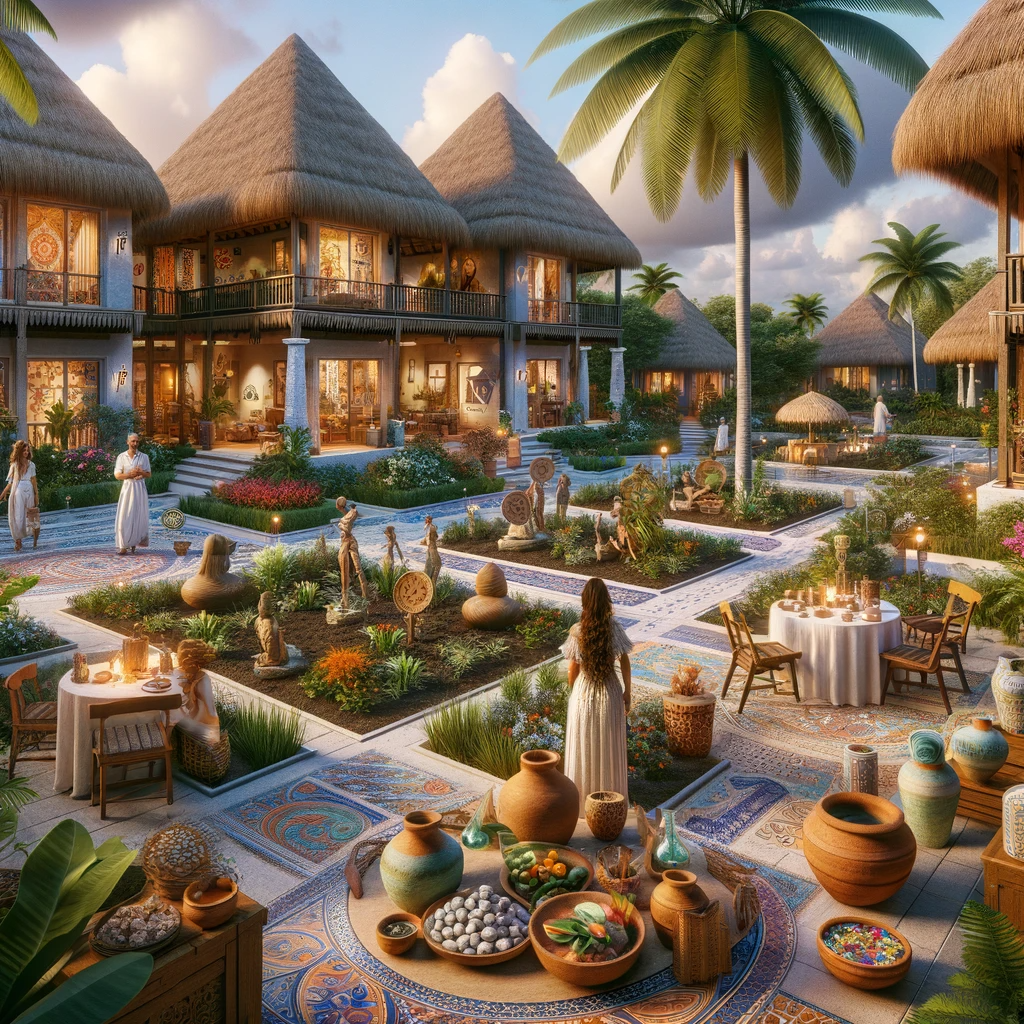
- Pathways and Walkways:
- Material Selection:
- Natural Stone: Using local stones like coral stone or limestone for pathways. These materials are durable, aesthetically pleasing, and blend well with the tropical environment. They can be laid in unique patterns or as stepping stones amidst grass or ground cover.
- Crushed Shells: In beachfront areas, pathways made of crushed shells can create a distinctive coastal look. They’re sustainable, provide excellent drainage, and their light color reflects the sun, keeping the path cooler.
- Pebbles and Gravel: These materials are excellent for creating informal, permeable walkways, ideal for garden areas. They allow for water infiltration and are low maintenance.
- Design and Layout:
- Curved Pathways: Designing pathways with gentle curves to create a more natural and inviting flow through the landscape. This can lead residents on a scenic route, enhancing their experience of the outdoor space.
- Boardwalks: In sensitive areas like dunes or wetlands, elevated wooden boardwalks can provide access while protecting the ecosystem. These can be made from sustainable hardwoods or composite materials resistant to rot and insects.
- Edging and Borders:
- Natural Edging: Using rocks, larger stones, or even tropical plants like agave or ornamental grasses to edge pathways. This helps define the paths and adds to the overall aesthetic.
- Raised Beds and Planters: Along the walkways, raised beds or planters can be used to add height and interest, showcasing native plants or seasonal flowers.
- Accessibility:
- Smooth Surfaces: Ensuring that the primary walkways have smooth, even surfaces for accessibility. This is important for residents and guests who may have mobility challenges.
- Adequate Width and Lighting: Make sure pathways are wide enough to accommodate multiple people or mobility aids and are well-lit for safety and usability at night.
- Integration with Landscape:
- Seating and Rest Areas: Incorporating seating areas or benches along the pathways, offering places for residents to rest and enjoy the surroundings.
- Water Features: Adding small water features like a pond or fountain near pathways can create a focal point and enhance the sensory experience with the sound of water.
- Environmental Considerations:
- Permeability: Emphasizing permeable materials to allow rainwater to seep through, reducing runoff and erosion, and aiding in groundwater recharge.
- Heat Reflective Colors and Materials: Choosing materials that reflect rather than absorb heat, is especially important in the sunny Caribbean climate to maintain comfortable walking conditions.
- Material Selection:
By thoughtfully designing the pathways and walkways, they become more than just functional aspects of the landscape; they contribute to the overall beauty and experience of the home’s design, encouraging exploration and enjoyment of the natural surroundings.

Expanding on sustainable practices in landscaping your home or investment property in Belize.
- Sustainable Practices:
- Eco-Friendly Material Use:
- Recycled and Local Materials: Prioritizing the use of recycled materials and sourcing locally available construction materials to minimize the carbon footprint. This could include reclaimed wood for decking or local stone for walls and pathways.
- Sustainable Timber: Using timber from certified sustainable sources for any wooden structures, ensuring that it doesn’t contribute to deforestation.
- Energy Efficiency:
- Solar-Powered Lighting: Implementing solar-powered lights for pathways, common areas, and landscape features. These are energy-efficient and reduce reliance on grid electricity.
- LED Lighting: Use LED bulbs for all outdoor lighting, which are more energy-efficient and have a longer lifespan compared to traditional bulbs.
- Water Management:
- Smart Irrigation Systems: Installing irrigation systems equipped with sensors that adjust watering based on weather conditions, soil moisture levels, and plant requirements, thereby conserving water.
- Permeable Paving: Using permeable materials for parking areas and walkways to allow rainwater to percolate into the ground, reducing runoff and aiding in groundwater recharge.
- Wildlife Preservation:
- Bird and Bat Houses: Installing bird and bat houses to encourage these species to reside in the area, aiding in insect control and pollination.
- Native Plantings: Using native plants that provide food and habitat for local wildlife, promoting biodiversity.
- Waste Management:
- Composting Facilities: Establishing composting facilities for garden and organic waste. This compost can then be used as a natural fertilizer in the gardens.
- Recycling Bins: Providing clearly marked recycling bins in common areas to encourage waste separation and recycling.
- Green Roofs and Walls:
- Green Roofs: Installing green roofs on suitable structures, helps in insulation, reducing the urban heat island effect, and creating additional green spaces.
- Living Walls: Incorporating living walls in common areas, can improve air quality, provide insulation, and enhance aesthetic appeal.
- Education and Engagement:
- Educational Signage: Placing educational signs about the sustainable features and practices used in the landscaping. This can inform and inspire residents and visitors to adopt similar practices.
- Community Involvement: Encouraging community involvement in sustainable practices, like participating in tree planting days or maintaining a community vegetable garden.
- Eco-Friendly Material Use:
By integrating these sustainable practices, the landscaping not only enhances the aesthetic appeal of the luxury homes and condos in Secret Beach but also ensures environmental responsibility and promotes a healthier, more sustainable living environment for residents and local wildlife.
Expanding on the concept of designing wildlife-friendly landscapes for a luxury home or investment property in Belize:
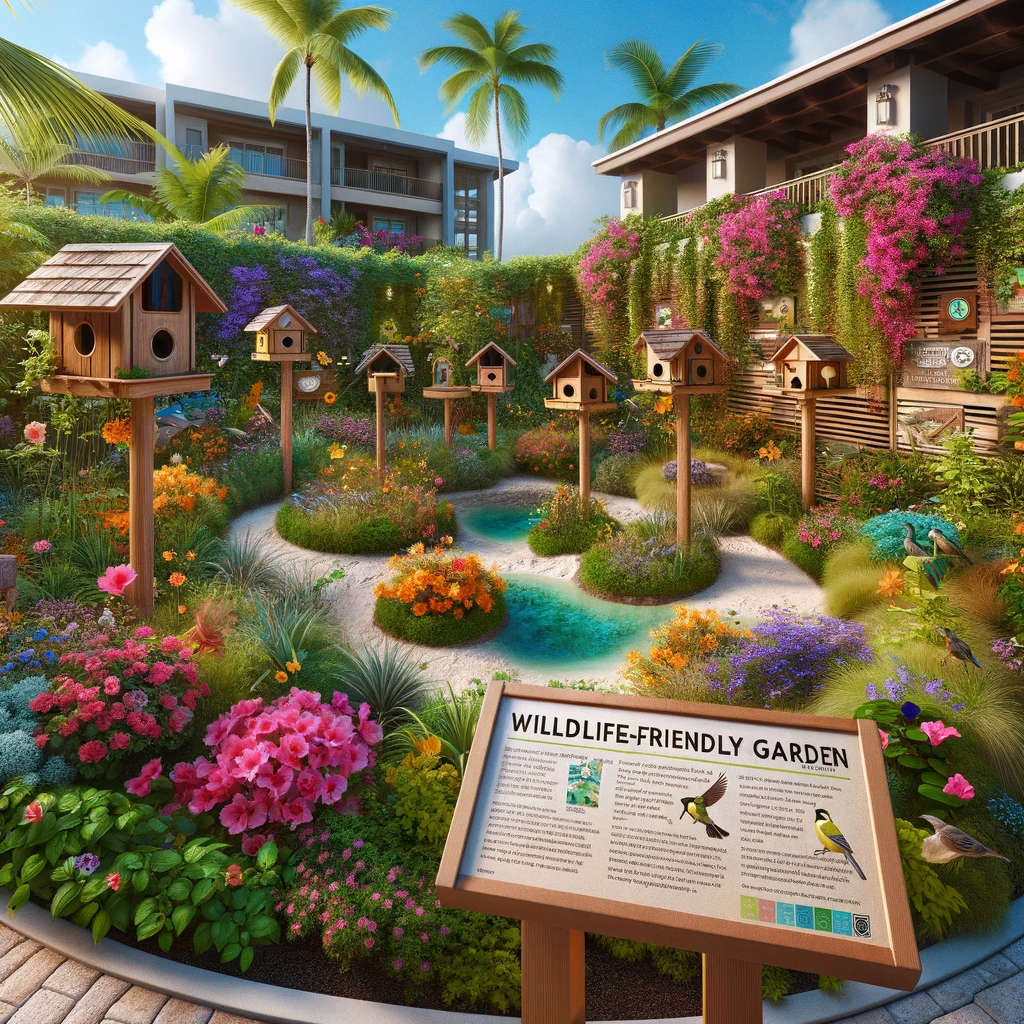
- Wildlife Friendly:
- Native Plant Gardens:
- Pollinator-Friendly Plants: Planting native flowering plants that attract pollinators like bees, butterflies, and hummingbirds. Species such as Milkweed, Wild Sage, and Lantana are excellent choices.
- Fruit-Bearing Trees: Including native fruit-bearing trees and shrubs, like Mango, Papaya, and Sea Grape, which provide food for birds and other wildlife.
- Habitat Creation:
- Birdhouses and Nesting Boxes: Installing birdhouses and nesting boxes tailored to local bird species, placed in safe, quiet areas of the landscape.
- Bat Boxes: Encouraging natural pest control by installing bat boxes, as bats are excellent at controlling mosquito populations.
- Water Features:
- Ponds and Birdbaths: Creating small ponds or birdbaths, which can provide a water source for birds, butterflies, and other wildlife. These features should be shallow and have easy access for small creatures.
- Fish and Aquatic Life: If larger water features are used, they can be stocked with native fish and designed to support local aquatic life.
- Naturalized Areas:
- Wildflower Meadows: Allocating areas to grow as wildflower meadows, which are not only beautiful but also provide habitats for a variety of wildlife.
- Brush Piles: Creating small, discreet brush piles in less trafficked areas to offer hiding spots and habitats for small animals and insects.
- Integrated Pest Management:
- Chemical-Free Practices: Avoiding the use of chemical pesticides and fertilizers that can harm wildlife. Opting for organic or natural pest control methods.
- Beneficial Insects: Encouraging the presence of beneficial insects, like ladybugs and praying mantises, which naturally control pest populations.
- Educational Aspects:
- Informational Signage: Installing signs to educate residents and visitors about the local wildlife and the importance of the eco-friendly features in the landscape.
- Guided Nature Walks: Offering guided walks through the landscape to highlight and educate about the local flora and fauna.
- Sensory Experience:
- Viewing Areas: Design specific areas where residents can quietly observe and enjoy the presence of wildlife, like bird-watching stations or butterfly gardens.
- Sensory Plants: Incorporating plants that stimulate the senses, like fragrant flowers or plants with interesting textures, to enhance the overall experience.
- Native Plant Gardens:
By creating a wildlife-friendly environment, the landscaping not only supports local biodiversity but also provides an enriching and educational experience for the residents of Secret Beach, fostering a deeper connection with the natural world and the country of Belize.
By expanding on the ideas for creating privacy and windbreaks in the landscaping of a new home subdivision in Secret Beach you can remain connected to the natural world while at the same time having privacy when you are in a natural state.

By expanding on the ideas for creating privacy and windbreaks in the landscaping of a new home subdivision in Secret Beach you can remain connected to the natural world
- Privacy and Windbreaks:
- Strategic Plant Placement:
- Tall Hedges and Shrubs: Use tall, dense hedges and shrubs like Areca Palm, Clusia, or Hibiscus to create natural privacy screens. These can be trimmed to maintain a desired height and shape.
- Layered Planting: Implementing a layered approach by combining trees, shrubs, and ground covers. This not only provides privacy but also adds depth and texture to the landscape.
- Natural Windbreaks:
- Trees and Shrubs: Planting rows of trees and shrubs that act as windbreaks, is especially important in coastal areas. Species like Sea Grape and Buttonwood are ideal for their tolerance to wind and salt spray.
- Varying Heights: Using plants of varying heights to create a more effective barrier against wind. Tall trees can protect against high winds, while lower shrubs guard against soil erosion.
- Living Walls and Vertical Gardens:
- Freestanding Walls: Constructing living walls or vertical gardens, which can serve as privacy screens while adding a green, lush element to the environment.
- Climbing Plants: Utilizing climbing plants on trellises or fences to create green screens. Bougainvillea, Passion Flower, and Morning Glory are excellent choices for their rapid growth and vibrant flowers.
- Built Structures:
- Decorative Fencing: Incorporating decorative fencing that complements the architectural style of the condo, providing privacy while adding an aesthetic element.
- Pergolas and Gazebos: Building pergolas or gazebos with draping vines or climbing plants. These structures can provide secluded areas for relaxation and entertainment.
- Wind-Resistant Features:
- Boulders and Rock Structures: Placing boulders or creating rock structures that can deflect wind while adding a natural, rugged look to the landscape.
- Berms: Constructing berms, which are mounded hills of soil, covered with grass and plants, to help reduce wind speed and noise.
- Sustainable Practices:
- Native Plants: Use native plants for privacy and windbreaks, as they are more likely to thrive and require less maintenance.
- Mulching: Applying mulch around plants to reduce soil erosion, particularly in windy areas.
- Consideration of Views:
- Selective Pruning: Regularly pruning and shaping plants to maintain desired privacy levels while preserving scenic views, especially important in a coastal setting.
- Transparent Elements: Where appropriate, use transparent or semi-transparent elements like glass panels or open fences to balance privacy with open views.
- Strategic Plant Placement:
By thoughtfully incorporating these elements, the landscaping can provide effective privacy and wind protection, enhancing the living experience for residents of Secret Beach while preserving the natural beauty and views of the Caribbean setting.
Ideas for beachfront considerations in the landscaping of a waterfront home in Secret Beach:

- Beachfront Considerations:
- Respecting the Ecosystem:
- Dune Preservation: Avoid disturbance to existing sand dunes, which are crucial for coastal protection and habitat. Planting or reinforcing dunes with native grasses like sea oats can help stabilize them.
- Buffer Zones: Establishing buffer zones between the landscaped area and the beach. This helps protect the beach ecosystem and prevents landscaping elements from encroaching on the natural habitat.
- Salt-Tolerant Plantings:
- Choosing Salt-Tolerant Species: Utilizing plants that can withstand salt spray, like Sea Grape, Coconut Palm, and Silver Buttonwood. These plants are well-adapted to beachfront conditions and require less maintenance.
- Strategic Placement: Positioning salt-tolerant plants in areas most exposed to sea spray, creating a natural barrier to protect more sensitive plants inland.
- Erosion Control:
- Ground Covers: Planting ground covers that can help bind the soil and prevent erosion, is especially important in sandy beachfront areas. Creeping plants like Beach Morning Glory are effective.
- Retaining Walls and Terracing: Constructing low retaining walls or terracing sloped areas with rocks or native materials, where necessary, to manage erosion while maintaining a natural look.
- Sustainable Materials:
- Avoiding Hard Paving: Minimizing the use of impervious materials for paths and patios near the beach to prevent runoff and erosion. Opting for permeable materials or wooden boardwalks.
- Eco-Friendly Furniture: Choosing outdoor furniture made from materials that withstand humid, salty air without degrading, such as recycled plastics, teak, or stainless steel.
- Minimizing Light Pollution:
- Turtle-Friendly Lighting: In areas where sea turtles nest, use turtle-friendly lighting to prevent disorienting hatchlings. This includes keeping lights low to the ground and using long-wavelength amber LEDs.
- Shielded Fixtures: Using shielded light fixtures that direct light downward to reduce light pollution and its impact on the marine environment.
- Water Management:
- Rain Gardens and Bioswales: Creating rain gardens or bioswales near the beachfront to capture runoff and filter pollutants, protecting water quality.
- Irrigation Practices: Using freshwater wisely and avoiding overwatering to prevent freshwater intrusion into the saline beach ecosystem.
- Responsible Maintenance:
- Organic Practices: Employing organic maintenance practices, and avoiding synthetic fertilizers and pesticides that can harm the beach environment.
- Regular Cleanups: Organizing regular beach cleanups to maintain the cleanliness and natural beauty of the beachfront.
- Educational Signage and Programs:
- Informative Signage: Placing signs to educate residents and visitors about the importance of preserving the beachfront ecosystem and the measures taken in the landscaping to support this.
- Interactive Programs: Hosting educational programs or guided walks to engage residents in learning about and participating in beachfront conservation efforts.
- Respecting the Ecosystem:
By carefully considering these beachfront-specific factors, the landscaping of the new home in Secret Beach can be both beautiful and responsible, enhancing the beach environment while providing a sustainable and enjoyable living space for residents.

Incorporating Belizean cultural elements into the landscaping of a luxury home in the Caribbean:
- Cultural Elements:
- Artistic Features:
- Sculptures and Art Installations: Including sculptures or art installations created by local Belizean artists. These pieces can reflect the rich cultural heritage and history of Belize, such as Mayan motifs or representations of local wildlife and marine life.
- Mural Walls: Commissioning local artists to paint murals that depict scenes from Belizean folklore, landscapes, or traditional life, adding vibrant visual interest to communal areas.
- Architectural Influences:
- Traditional Belizean Structures: Integrating architectural elements inspired by traditional Belizean homes, such as thatched palapas in common areas, providing shade and a sense of place.
- Decorative Tile Work: Using brightly colored, hand-painted tiles in areas like walkways, pools, or walls, showcasing traditional Belizean patterns and designs.
- Gardens and Planting:
- Medicinal and Herbal Gardens: Creating gardens that feature plants used in traditional Belizean herbal medicine, like Aloe Vera, Lemongrass, and Basil. This not only adds an educational element but also pays homage to the traditional uses of local flora.
- Fruit and Vegetable Gardens: Incorporating areas where traditional Belizean fruits and vegetables are grown, such as Pineapple, Cassava, and Sweet Potato, which can be used in the condo’s culinary offerings.
- Cultural Landscaping Features:
- Mayan-Inspired Water Features: Designing water features or small reflecting pools that draw inspiration from ancient Mayan architecture and water management systems.
- Stone Pathways: Creating pathways using local stones arranged in patterns reflective of Belizean art or traditional weaving patterns.
- Furniture and Décor:
- Handcrafted Furniture: Using furniture made by local craftsmen, incorporating materials like Belizean hardwoods and woven fibers, which support local artisans and add unique character to the space.
- Textiles and Fabrics: Including cushions, curtains, or hangings made from traditional Belizean textiles, featuring vibrant colors and patterns.
- Cultural Events and Spaces:
- Event Spaces: Designing multipurpose spaces that can be used for cultural events, such as local music performances, dance, or craft workshops, encouraging cultural exchange and community involvement.
- Storytelling Areas: Creating cozy areas designed for storytelling or sharing of local legends and histories, fostering a sense of community and connection to Belizean culture.
- Sustainability and Tradition:
- Traditional Techniques: Employing traditional landscaping and building techniques that have been passed down through generations, blending modern sustainability with historical practices.
- Eco-Cultural Tourism: Encouraging eco-cultural tourism through landscaping, allowing visitors to experience and learn about Belizean culture in an environmentally responsible manner.
- Artistic Features:
By thoughtfully integrating these Belizean cultural elements into the landscaping, the home in Secret Beach can offer a unique and authentic experience that not only celebrates but also helps to preserve the rich cultural heritage of Belize.
A sustainable maintenance plan for the landscaping of a new home or resort community in Belize:
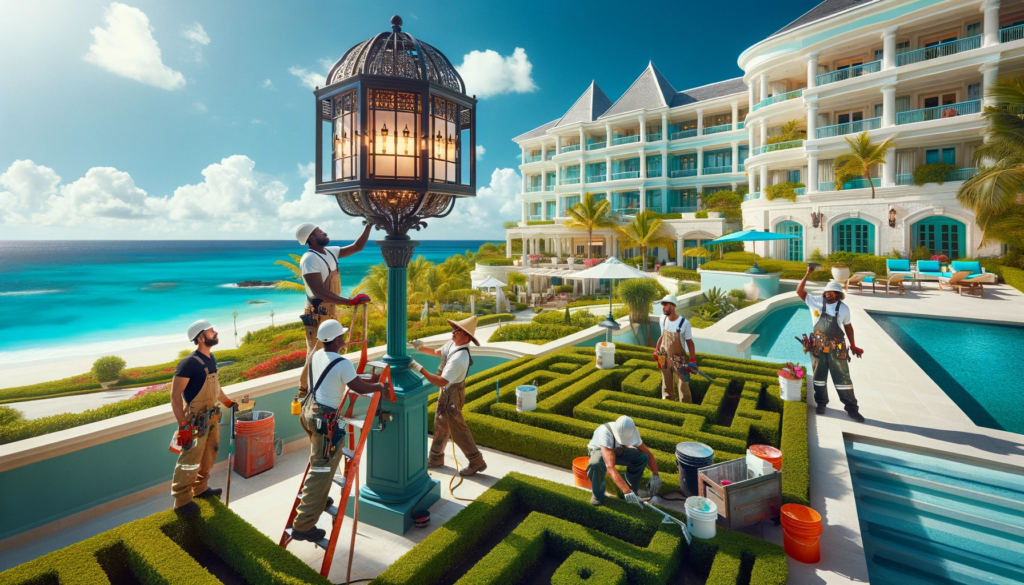
- Maintenance Plan:
- Organic Gardening Practices:
- Natural Fertilizers: Utilizing organic fertilizers made from composted materials, which are healthier for the soil and plants and reduce chemical runoff into the environment.
- Companion Planting: Implementing companion planting strategies where certain plants are grown together to enhance growth, deter pests, and improve soil health.
- Integrated Pest Management (IPM):
- Biological Control: Introducing beneficial insects or other natural predators to manage pest populations without resorting to chemical pesticides.
- Physical and Mechanical Controls: Using physical barriers, like netting or fencing, and manual removal methods for pest control where feasible.
- Water Management:
- Regular System Checks: Conduct regular checks and maintenance of irrigation systems to ensure they are operating efficiently and to prevent water wastage.
- Adjusting Irrigation Schedules: Regularly adjusting irrigation schedules based on seasonal changes and weather patterns to optimize water usage.
- Pruning and Trimming:
- Scheduled Pruning: Establishing a regular schedule for pruning and trimming trees, shrubs, and hedges to maintain their shape, encourage healthy growth, and prevent overgrowth.
- Selective Pruning: Carefully selecting which branches or sections to prune to preserve the natural shape of the plants and the overall aesthetic of the landscape.
- Lawn Care:
- Eco-friendly Lawn Maintenance: Using reel mowers or electric mowers for lawn care to reduce emissions. Implementing aeration and overseeding techniques to maintain a healthy, dense lawn.
- Organic Weed Control: Managing weeds through organic methods, such as mulching, hand-pulling, or using organic herbicides.
- Mulching:
- Regular Mulching: Applying mulch around plants and trees to conserve soil moisture, regulate temperature, and suppress weeds.
- Sustainable Mulch Sources: Use locally sourced or recycled materials for mulch, such as shredded leaves, pine needles, or compost.
- Tree and Plant Health Monitoring:
- Regular Health Checks: Conducting regular inspections of trees and plants for signs of disease or stress, and taking appropriate actions to treat or prevent issues.
- Soil Testing: Periodically testing soil for nutrient levels and pH balance to ensure optimal growing conditions.
- Staff Training and Education:
- Training Maintenance Staff: Providing ongoing training for the landscaping maintenance staff on sustainable practices and the specific needs of the native and adapted plants.
- Educational Workshops for Residents: Offering workshops or informational sessions for residents on sustainable gardening practices and how they can contribute to the landscape’s health.
- Record Keeping and Review:
- Maintenance Logs: Keeping detailed logs of all maintenance activities, including pruning, planting, fertilizing, and irrigation, to track the landscape’s health and maintenance needs.
- Periodic Review and Adjustment: Regularly review the maintenance plan and make adjustments based on the landscape’s performance, environmental changes, and advancements in sustainable practices.
By implementing a sustainable maintenance and project management plan, the landscaping not only remains vibrant and healthy but also contributes to the ecological balance, ensuring a beautiful and sustainable environment for the residents of the Secret Beach area.

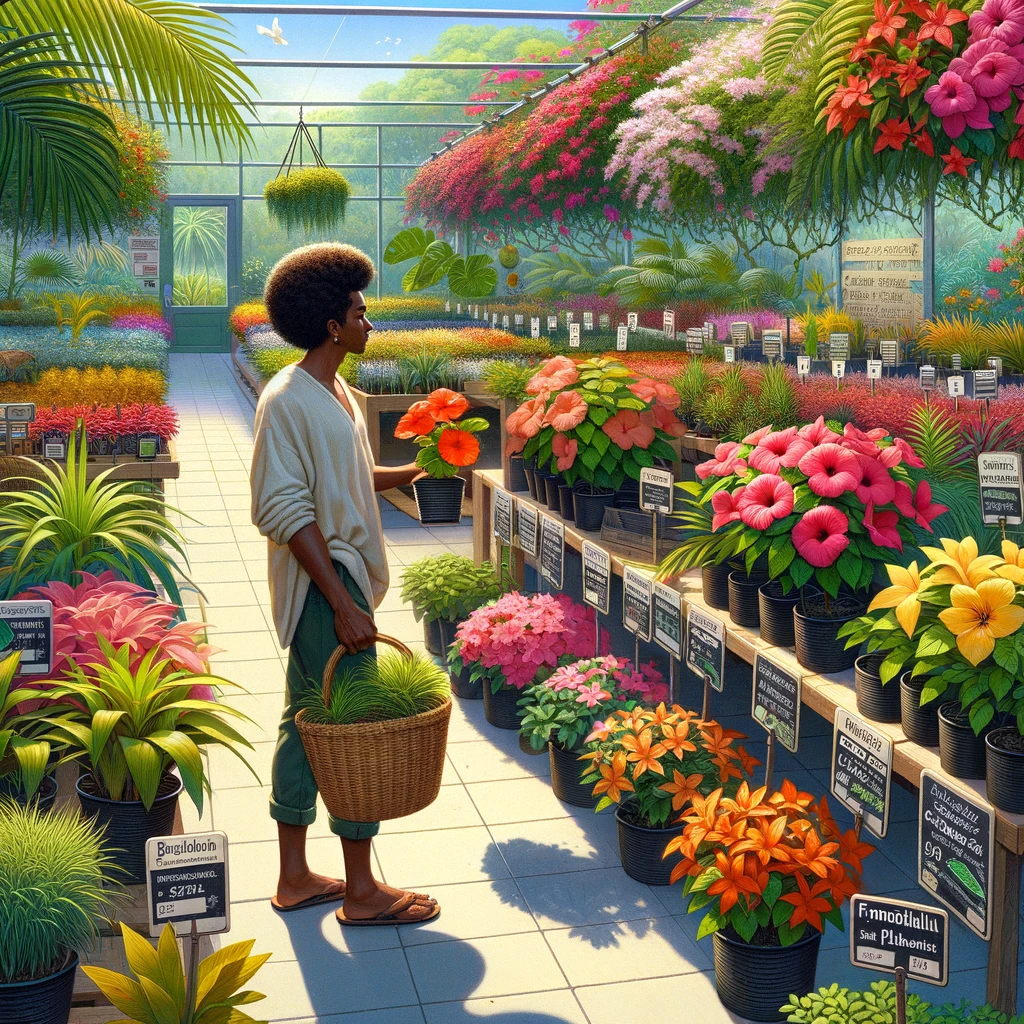
1 thought on “Landscaping your property in Secret Beach and Ambergris Caye”
Comments are closed.